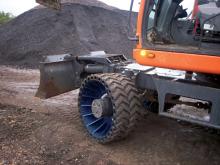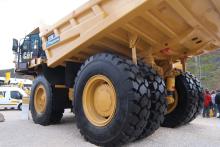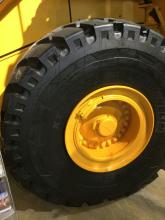Getting the right tyres for a quarry is not just a case of getting the right size for the machine - getting the right tread pattern and compound, as well as the right maintenance, can also affect tyre service life. Claire Symes reports
The high cost involved in buying new
"The UK illustrates the difference that climate conditions can have on tyre life," said
"Quarries need to take everything into account when they are selecting tyres in order to get the right tyre for the right job.
"We have started doing analysis for customers that is partly based on observation of the site and using data collected by a system designed by Race Logics. This investigation looks at all aspects of the operation including the haul road condition, rainfall at the site and the condition of previous tyres.
"One thing that has been clear is that many quarries are not getting the best out of tyre technology. Many quarries have a clear understanding of the cost per tonne of production but not the need to look more closely at tyre usage and its influence on the bottom line." Aitken said that the analysis of sites has highlighted some interesting things that may not always be apparent. "One of the main things we've observed is that quarries with tight turns on haul roads which don't have banking result in load transference that can have a big impact on tyre wear," he said. "The solution is to increase the radius of these bends or add banking." Another quarry layout issue that may also impact on tyre life is a lack of room in the loading and unloading areas. "If there isn't much space then the trucks are frequently turning at low speed on full lock and this results in higher wear," said Aitken.
He added that there is a tendency to just use the same tyres as before and not review what is available. "Conditions in the site may have changed as the extraction progresses so what was the ideal solution before may no longer be," he said. "This is where having the box to record real figures helps with the decision to change tyres and makes the approach more scientific."
Shortage benefits
According to Aitken, although the tyre shortages a few years ago were horrendous for the sector, it helped to highlight the benefits of better tyre care and the repair options available. This knowledge has also stood quarry operators in good stead when it has come to reducing costs in the current financial conditions.
"Repair became a more popular option than before," he said. "The radial and steel design means that major repairs are possible on quality tyres. Retreading also became a more popular option and highlighted the more sustainable approach this method offers." Bridgestone OTR tyres assistant manager sales and marketing Matthieu Bouesnard said, "Indeed tyre repair was given a push by the tyre shortage as it was just sometimes not possible to get a new tyre. There are now many specialists in the market."
Italy-based Maragoni has long been a promoter of retreading and has been carrying out this kind of repair for 60 years. "Thanks to the careful selection and repair of the casing, the performance of retreads can be equivalent to new tyres of premium brands," said Maragoni technical assistance manager Fabrizio Finotti.
"There are advantages in retreading for the environment, as the process reuses a casing that would otherwise be dumped in landfill or disposed of when in fact it still has potential uses and consequently an economic value that can be exploited. However, a good retread starts with a good casing, so an initial investment in a premium tyre is important to get the most from reusing a worn tyre."
While the tyre shortage may have ended, the cost of tyres is still rising, making it increasingly essential to get the most from a tyre's service life. "One of the challenges facing all of the companies in the industry this year is to manage this hike in raw material prices, which affects everything and not just rubber," explained Marangoni sales executive manager Luca Mai.
Marangoni works directly with the customer and retreads their tyres rather than marketing finished products. The company claims to offer higher levels of quality by transporting tyres to its factory in Roverto, Italy to carry out the retreading.
"It is always beneficial if a quarry operator works closely with the tyre manufacturer and their local service provider," said Aitken. "In these situations the standard of tyre husbandry is always raised. "There are always ways to save money when it comes to tyres - operating at the right pressure is one of the simplest but the benefits go beyond extending the tyre life. As tyres are pneumatic, then having the right pressure ensure an even contact pattern with the ground, which not only creates even wear but helps improve braking operations and reduces wear on the machine as a whole.
"Checking the pressure regularly - whether weekly or monthly - is key. Get it right and good things start to happen. For a start an improved ride means less wear on the suspension and a better ride means the operator will suffer less from fatigue caused by vibration." Aitken urges quarry operators to ask the tyre manufacturer for advice if they are unsure of what pressure they should be operating at.
Bouesnard agreed and added, "Tyre inflation pressures have a direct impact on life - a 20% under inflation can cause a 20% life reduction of the tyre. Proper follow up can extend life and save money."
Driving forces
"The operator is also one of the biggest variables influencing tyre life," said Aitken. "Incentivising drivers to look after tyres has worked well for some quarry customers, especially where conditions are very wet as rubber is easier to cut when wet.
"It also helps to encourage drivers to inspect tyres on a regular basis. Tyres do get damaged but if the problem is spotted early enough, many tyres can be repaired - they are designed to be repaired but it is important to use an accredited repairer to get the best results. Also a driver may not understand the severity of the damage and this is when a close partnership with the manufacturer and local service provider will pay dividends."
Design influence
"Heat is the biggest killer when it comes to tyre life," said Aitken. "In general, using the right tyre for the job at the right pressure minimises the heat generated. But different tyres have a different capacity to dissipate heat, so a compound designed to resist damage may not be so good at dissipating heat. However, a tyre designed for traction will have more blocks creating a greater surface area and greater cooling. The ideal solution will always involve some compromise." Tyre design has become more important in recent years, according to Aitken. "Take loading shovels, for example," he said. "The machine design used to be very basic and you could have fitted square tyres to the machine without much impact on the ride quality. Today's machines are much more hi-tech and vibration is a bigger issue so we have developed tyres to help minimise vibration." Like machine innovation, development of new tyre technology.
looks set to continue with new tread, cross section and compound designs expected to deliver better productivity and longer service life. Bouesnard said, "The specific tyre compounds and design is confidential but our technical centre is constantly working on tyre compound, design and construction to improve wear life and bring additional value to our customers ."









